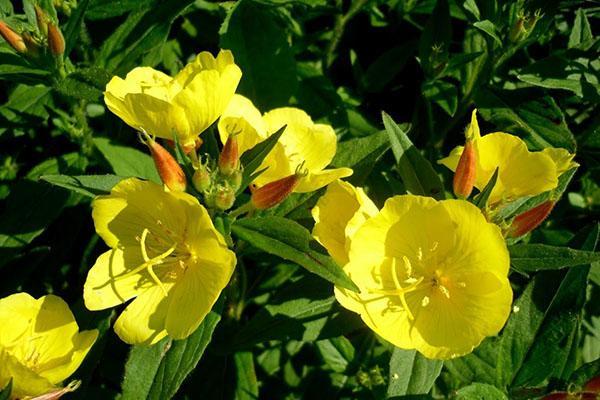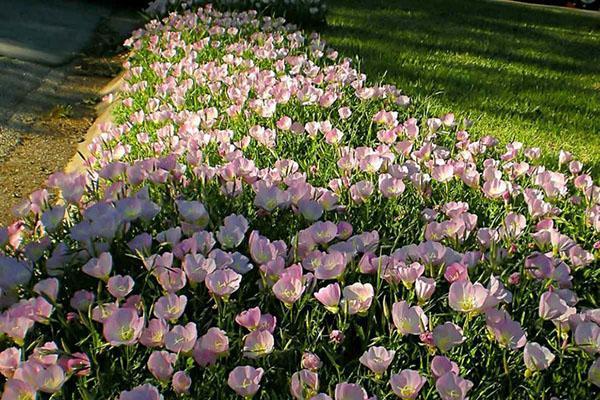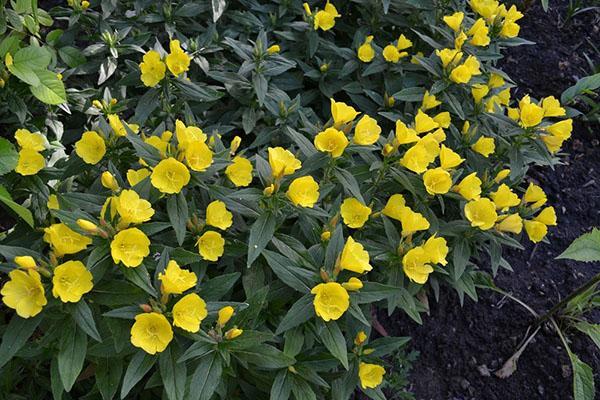Planting and caring for perennial evening primrose
 Knowing what the planting and caring for perennial evening primrose should be like, you can grow a beautiful and healthy plant. This is a unique culture that not only has a beautiful appearance, but also has healing properties. How to properly plant and care for perennial evening primrose can be seen in the photo below.
Knowing what the planting and caring for perennial evening primrose should be like, you can grow a beautiful and healthy plant. This is a unique culture that not only has a beautiful appearance, but also has healing properties. How to properly plant and care for perennial evening primrose can be seen in the photo below.
Description and main types of evening primrose

The most popular are the following types of evening primrose:
- Fragrant evening primrose. Shade-loving representative of "night primrose". The variety is best placed near trees or some kind of canopy that gives shade. The tall plant reaches a meter in height, it goes well in flower beds with other, lower flowers. The fragrant evening primrose has very large yellow flowers, open day and evening.

- Large-flowered or biennial evening primrose. The donkey grows up to 2 meters, therefore it is very popular. Reveals bright yellow inflorescences during the day, spreads a very pleasant aroma.

- Shrub evening primrose. The variety forms strong stems about 90 cm tall, they are highly branched, yellow. In the autumn, the leaves of the plant change color from green to burgundy, which looks very beautiful with flowers.

- The Missouri variety came to us from the southern part of North America. A perennial rarely exceeds 40 cm in height. Planting and caring for Missouri evening primrose is no different from other species. The buds are very large, resembling cups, reaching 10 cm in diameter. During flowering, a delicate aroma with a light citrus hue appears. The flowering period is from summer to almost frost.

- The quadrangular variety of primrose was also brought to our region from North America. Blossoms in June and blooms until the end of summer. Winters well, does not freeze. It is easy to plant it by dividing the bushes into parts. The specimens are about 70 cm high.

Beautiful evening primrose is no less popular. The flower grows up to 60 cm tall. Small buds of pink or white shade. The value of a plant is not only in beauty. The donkey is also used in medicine; cosmetic mixtures are prepared from it.
Planting and caring for perennial evening primrose
 The plant is demanding for good lighting, but it can grow in rather shaded areas. Planting and caring for perennial evening primrose of different species is the same. With regular fertilization, loosening the soil, the flower tolerates frost well.
The plant is demanding for good lighting, but it can grow in rather shaded areas. Planting and caring for perennial evening primrose of different species is the same. With regular fertilization, loosening the soil, the flower tolerates frost well.
Evening primrose does not tolerate excess moisture, so it is better to plant it on sandy soils or loam.
The soil for this flower should be fairly loose, with sufficient air permeability. It is necessary that water does not accumulate in the ground, otherwise it will quickly lead to rotting of the roots of the flower and its death.
At the end of winter, you need to prepare the beds with evening primrose so that it endures the winter well. The aerial part of the stems is pruned without regret. Near the root, the ground is covered with a mixture for mulching a layer of 6-7 cm. You can use compost or peat for these purposes.Pruning not only helps to withstand frost, but also regulates the growth of the bush. If this is not done, then the lush evening primrose will "drown out" the neighboring flowers.
 The donkey does not cause much trouble to its owners when growing. Another big "plus" of this flower is that it rarely gets sick, pests practically do not settle on it. The only "sore" that haunts yellow flowers is the ubiquitous powdery mildew.
The donkey does not cause much trouble to its owners when growing. Another big "plus" of this flower is that it rarely gets sick, pests practically do not settle on it. The only "sore" that haunts yellow flowers is the ubiquitous powdery mildew.
First, all parts of the plant are covered with a whitish bloom. Later, it darkens, and the affected leaves and buds turn brown. The plates curl, dry, fall off. The formed buds dry out even before they begin to bloom. In order to prevent powdery mildew, beds with "night primrose" must be treated with sulfur before bud formation begins. If plaque begins to form, then the leaves should be washed with a solution of soap and soda.
 In order for the plant to please with abundant flowering, it needs top dressing. The ideal option is complex fertilizers. In the summer they bring superphosphate at the rate of a tablespoon per square meter. This should be done before flowering begins. When the yellow buds bloom, you should make a special feeding for flowering plants. It is beneficial to feed evening primrose during this period with wood ash (2 tablespoons per square meter) or potassium sulfate (1 tablespoon per square meter).
In order for the plant to please with abundant flowering, it needs top dressing. The ideal option is complex fertilizers. In the summer they bring superphosphate at the rate of a tablespoon per square meter. This should be done before flowering begins. When the yellow buds bloom, you should make a special feeding for flowering plants. It is beneficial to feed evening primrose during this period with wood ash (2 tablespoons per square meter) or potassium sulfate (1 tablespoon per square meter).
Evening primrose breeding methods
Growing evening primrose from seeds is a very easy task. It is important to choose a suitable place for the plant.
Sowing in open ground
 Before planting evening primrose seeds, you should choose the best place. Since the plant is light-loving, it is best to choose the south side. Sowing can be carried out directly into the ground. To do this, in late summer or early autumn, ripe plant seeds are collected. If this is not done, then the ants will perform this task themselves and will spread the seeds of the "evening candle" throughout the territory of the site.
Before planting evening primrose seeds, you should choose the best place. Since the plant is light-loving, it is best to choose the south side. Sowing can be carried out directly into the ground. To do this, in late summer or early autumn, ripe plant seeds are collected. If this is not done, then the ants will perform this task themselves and will spread the seeds of the "evening candle" throughout the territory of the site.
Before sowing grains, humus should be added to the ground, as well as fertilizers containing a sufficient amount of phosphorus and potassium compounds. Then the soil is dug up, well watered. Sowing is carried out to a depth of about 3 cm, the seeds are slightly covered with earth.
Growing evening primrose seedlings
 Each method has its own advantages. Sowing seeds is much easier to do. But if you grow evening primrose from seedlings, then it will bloom magnificently in the first summer after planting. The bushes will be strong, huge. Therefore, florists often use this method when growing a primrose.
Each method has its own advantages. Sowing seeds is much easier to do. But if you grow evening primrose from seedlings, then it will bloom magnificently in the first summer after planting. The bushes will be strong, huge. Therefore, florists often use this method when growing a primrose.
Any plants, including evening primrose, should not be transplanted in the heat, when the bright sun is shining.
To get good seedlings, even in winter (in February), you need to sow seeds in pots filled with peat. They are placed in a greenhouse or covered with foil to speed up the germination of seeds. When the first leaves appear, the greenhouse is removed, and the seedlings are watered until 5-6 leaves appear. No earlier than May, it will be possible to plant it in the beds. The depressions are significant, about half a meter. Enough space is left between individual specimens for the formation of bushes - 50-60 cm. After planting, the sprouts should be well watered.
Dividing the bush
 Enotera can be successfully grown not only from seeds. Good results are obtained by separating the bushes of this flower. This must be done at the very end of spring or already at the beginning of autumn, when there is no heat. Parts of the plant are chosen so that they have creeping roots with a developed growth point.
Enotera can be successfully grown not only from seeds. Good results are obtained by separating the bushes of this flower. This must be done at the very end of spring or already at the beginning of autumn, when there is no heat. Parts of the plant are chosen so that they have creeping roots with a developed growth point.
Enotera is such a tenacious plant that it can be transplanted in the summer. The flower takes root well. The bushes do not wither for several days without planting in the ground and without abundant watering. After planting, the plant quickly takes root and begins to develop.
The bright sunny evening primrose flower, with proper care, will decorate any garden area.If you water and fertilize in a timely manner, then it will delight all summer with its beautiful flowering.